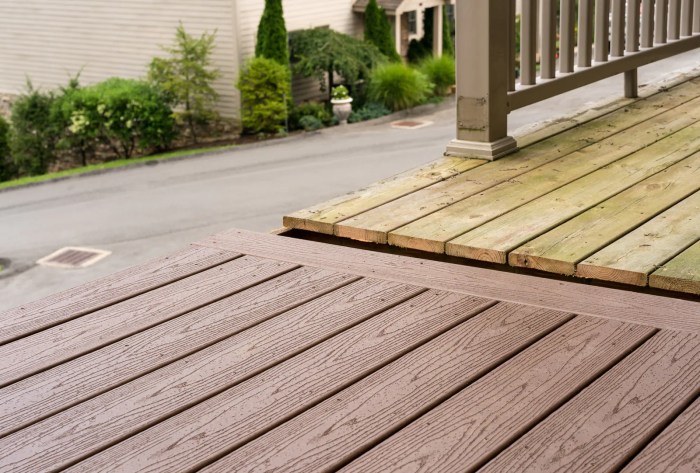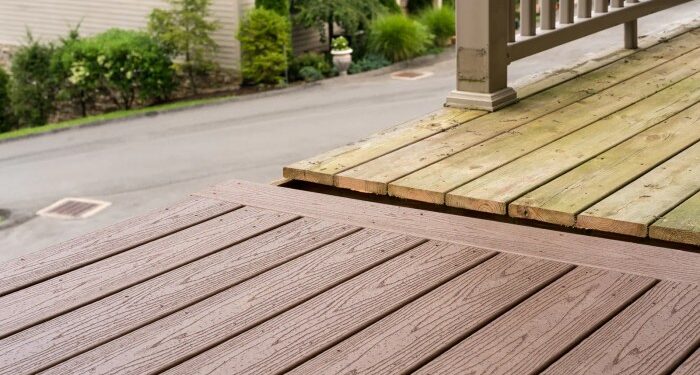When it comes to choosing between composite and wood decking, the decision can be quite daunting. From durability to aesthetics, each material offers unique benefits. Let's dive into the world of decking options and explore the differences between composite and wood, helping you make an informed choice for your next outdoor project.
Composite Decking vs Wood Decking
When it comes to choosing between composite decking and wood decking for your outdoor space, there are several key factors to consider. Let's take a closer look at the differences in durability, maintenance requirements, and costs between these two popular decking materials.
Durability
Composite decking is known for its durability and resistance to rot, mold, and insects. It is made from a combination of wood fibers and plastic, providing a longer lifespan compared to traditional wood decking. On the other hand, wood decking is prone to rot, splintering, and fading over time, requiring regular maintenance to prolong its lifespan.
Maintenance Requirements
- Composite decking requires minimal maintenance, typically only needing occasional cleaning with soap and water to keep it looking great. It does not need to be stained or sealed like wood decking, saving you time and money in the long run.
- Wood decking, on the other hand, requires regular staining, sealing, and refinishing to protect it from the elements and prevent decay. This maintenance can be time-consuming and costly over the years.
Cost Differences
While composite decking may have a higher upfront cost compared to wood decking, the long-term savings in maintenance and replacement costs make it a more cost-effective choice for many homeowners. Wood decking may be cheaper initially, but the ongoing maintenance and replacement costs can add up over time, making it a more expensive option in the long run.
Material Composition
Composite decking is made from a combination of wood fibers, recycled plastics, and binding agents. The wood fibers are often sourced from sawdust, wood chips, or bamboo, while the recycled plastics can come from items like plastic bags or bottles.
These materials are mixed together and compressed to create a durable and low-maintenance decking material.
Types of Wood in Wood Decking
Wood decking can be made from various types of wood, with the most common options being pressure-treated pine, cedar, and redwood. Pressure-treated pine is the most affordable option and is treated with chemicals to resist rot and insects. Cedar is a natural and aromatic wood that is naturally resistant to rot and insects.
Redwood is a more expensive option known for its durability and natural beauty.
Environmental Impact
Composite decking is often considered more environmentally friendly than wood decking. While wood decking can contribute to deforestation and requires the use of chemicals for treatment, composite decking utilizes recycled materials and reduces the demand for new wood. Additionally, composite decking requires less maintenance and does not need to be stained or sealed with harsh chemicals, further reducing its environmental impact.
Aesthetics and Design
When it comes to aesthetics and design, both composite decking and wood decking offer unique features that cater to different preferences and styles.Composite decking comes in a wide variety of colors and finishes, giving homeowners plenty of options to choose from to match their outdoor space.
Whether you prefer a natural wood look or a more modern, sleek appearance, composite decking can be found in different shades and textures to suit your taste.On the other hand, wood decking can also be customized to suit different design preferences.
With wood, you have the flexibility to stain or paint the decking boards in any color you desire. This allows for a more personalized touch and the ability to match the deck to the overall aesthetic of your home.When it comes to texture and feel, composite decking tends to have a smoother surface compared to wood decking.
While some people prefer the natural grain and texture of wood, others may appreciate the uniformity and low maintenance of composite decking. The choice between the two ultimately comes down to personal preference and the desired look for your outdoor space.
Installation Process

When it comes to installing decking, the process can vary depending on whether you choose composite or wood materials. Let's take a closer look at the installation process for composite decking and the tools required for wood decking, as well as compare the ease of installation between the two options.
Composite Decking Installation
Installing composite decking typically involves using hidden fasteners that attach the boards to the joists, giving a clean and seamless look. Here are some key steps involved in the installation process:
- Prepare the deck surface by ensuring it is clean, level, and free of any debris.
- Begin by laying the first board and securing it with the hidden fasteners.
- Continue installing the boards, making sure to leave a small gap between each to allow for expansion.
- Trim any excess material and add finishing touches to complete the installation.
Wood Decking Tools and Equipment
When it comes to installing wood decking, you will need a variety of tools and equipment to get the job done. Here are some of the tools required:
- Hammer or nail gun for securing the boards
- Saw for cutting the boards to size
- Level to ensure the deck surface is even
- Tape measure for accurate measurements
- Drill for pilot holes and screws
Comparison of Installation Ease
In terms of ease of installation, composite decking is often considered to be more straightforward compared to wood decking. This is mainly due to the use of hidden fasteners that create a seamless finish without the need for visible screws or nails.
Additionally, composite decking boards are often designed to be more uniform in size and shape, making it easier to create a consistent and professional-looking deck.Overall, while both composite and wood decking have their own installation requirements, many homeowners find that composite decking offers a simpler and more streamlined installation process compared to traditional wood decking.
Longevity and Lifespan
When it comes to the longevity and lifespan of decking materials, it is essential to consider various factors that can affect their durability over time.
Expected Lifespan
Composite decking typically has a longer lifespan compared to wood decking. While wood decking can last anywhere from 10 to 30 years with proper maintenance, composite decking can last up to 25 to 30 years or more. This longevity is due to the durable and weather-resistant nature of composite materials.
Climate and Weather Conditions
Climate and weather conditions play a significant role in determining the lifespan of both composite and wood decking. Extreme heat, cold, rain, snow, and humidity can all impact the durability of the materials. Composite decking tends to hold up better in harsh weather conditions, as it is resistant to moisture, rot, and insect damage.
Wood decking, on the other hand, may require more maintenance and protection from the elements to prevent warping, cracking, or decay.
Tips to Extend Lifespan
To extend the lifespan of both composite and wood decking, here are some tips:
- Regularly clean and maintain the decking to prevent mold, mildew, and stains.
- Apply a protective sealant or finish to wood decking to shield it from moisture and UV rays.
- Avoid using harsh chemicals or pressure washers that can damage the surface of the decking.
- Inspect the decking regularly for signs of wear and tear, and address any issues promptly to prevent further damage.
- Consider using a professional installation service to ensure the decking is properly installed and secure.
End of Discussion
As we conclude our exploration of composite vs wood decking, it's clear that both materials have their strengths and weaknesses. Whether you prioritize longevity, environmental impact, or customization options, understanding the nuances of each can lead to a deck that not only enhances your outdoor space but also fits your lifestyle seamlessly.
FAQ Guide
Which decking material is more durable?
Composite decking tends to be more durable than wood decking, as it is resistant to rot, decay, and insect damage.
What are the maintenance requirements for composite decking?
Composite decking requires minimal maintenance, usually limited to periodic cleaning with soap and water.
Is wood decking customizable in terms of design?
Wood decking can be customized through staining, painting, or choosing different wood species to achieve the desired look.
How does climate affect the longevity of decking materials?
Extreme weather conditions can impact both composite and wood decking, with proper maintenance and sealing helping to extend their lifespan.














